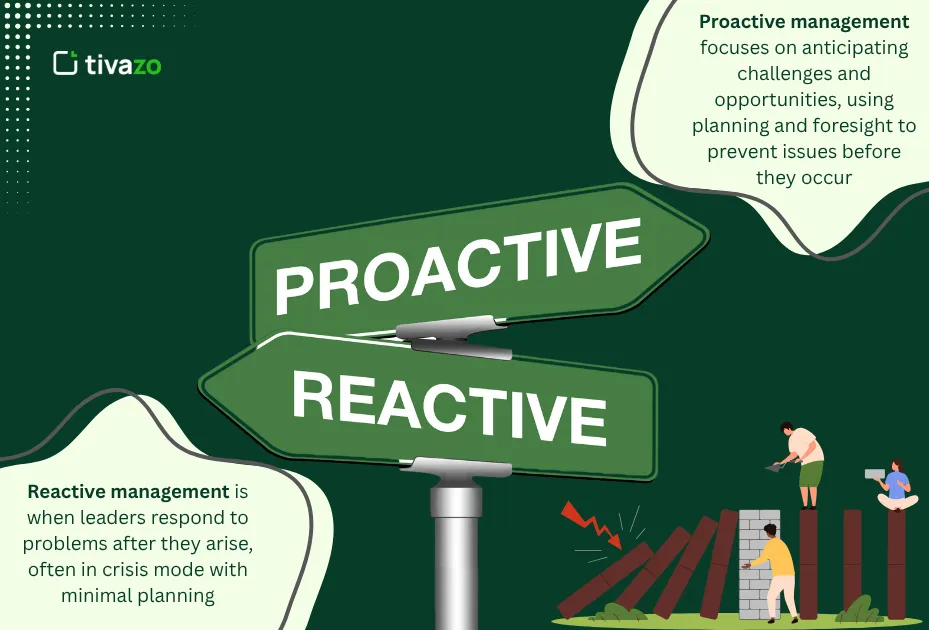Are you always fighting fires at work? Or are you preventing the fires from occurring in the first place? The difference in these two practices defines the basic distinction between reactive versus proactive management and can be the difference between improving your effectiveness as a leader and the overall success of your team.
In today’s rapidly changing business environment, the management style you choose to employ not only impacts your day-to-day responsibilities, it also affects your team’s morale, your organization’s culture, and it will ultimately determine if you are developing a successful workplace, or just trying to put out fire after fire after fire. Knowing when and how to use reactive versus proactive management has become a leadership skill that separates good leaders from those who can barely keep their heads above water.
This practical guide will help you learn the five magic moves that every smart leader should use—plus practical ideas to take your leadership from being reactive to being proactive.
What is Reactive vs Proactive Management?
Reactive Management is a leader’s management approach when managers respond to issues, challenges, and opportunities after they happen. Reactive management is about dealing with issues as they occur, often while in crisis mode, with little advance planning or prevention.
Proactive Management, on the other hand, involves anticipating potential challenges, opportunities, and changes before they happen. Proactive managers invest time in planning, prevention, and strategic thinking to avoid problems and capitalize on opportunities before they become urgent.
Key Differences Between Proactive and Reactive Management:
| Aspect | Reactive Management | Proactive Management |
|---|---|---|
| Timing | Responds after problems occur | Prevents problems before they happen |
| Planning | Minimal advance planning | Extensive strategic planning |
| Focus | Often inefficient, rushed decisions | Prevention and opportunity creation |
| Resource Usage | Often inefficient, rushed decisions | Optimized resource allocation |
| Team Impact | High stress, unpredictable environment | Stable, confident team atmosphere |
| Long-term Results | Short-term fixes, recurring issues | Minimal planning |
Is It Better to Be Proactive or Reactive?
Whether proactive management is better than reactive management is not always easy to figure out. While proactive management usually produces better results, good leaders recognize when proactive or reactive management is appropriate in different contexts.
When Proactive Management Works Well:
- Strategic planning and goal setting
- Developing teams and building skills
- Risk management and avoidance
- Innovative initiatives, growth opportunities.
- Cultivating organizational culture
When Reactive Management is Appropriate:
- Emergencies requiring immediate action or response
- Unexpected changes in the market or crises
- Resolving urgent customer complaints
- Addressing unexpected conflicts within a team
- Handling compliance or legal issues
The best leaders are proficient using proactive or reactive management; they evaluate how and when to strategically use either one!.
Pros and Cons of Proactive Leadership

Pros of Proactive Leadership:
Anticipates and Avoids Problems. Proactive management allows leaders to spot risky situations before they turn into big issues. By being forward-thinking and more aware of potential outcomes, proactive management saves time, money, and stress for managers and their teams.
Increases Team Morale and Confidence. The more predictable and proactive teams feel about their work environment, the more secure and confident they will be. Stability from a proactive management approach improves employee satisfaction and encourages employee retention
Better Planning and Resources. By proactively identifying waste or anticipating poor allocation of resources, proactive management allows leaders to allocate resources more efficiently and effectively.
Encourages Long-term Success and Innovation. Proactive management supports innovation where employees are able to think more broadly and more creatively, as such, are able to execute more successful change as they have time, space, and energy to pursue innovative solutions..
Cons of Proactive Leadership:
Requires Significant Time and Effort. Up-front Planning is hard and takes a lot of time and energy, which by its nature takes away from immediate action.
Can Create Over-planning and Inflexibility. Poor planning can create inflexibility in teams and managers to adapt quickly when there is an unexpected change in an opportunity that presents itself.
Requires Envisioning and Distant Vision. It is an absolute requirement that managers are naturally inclined and have developed the cognitive skills for strategic thinking for a proactive management plan to be effective.
Pros and Cons of Reactive Leadership

Pros of Reactive Leadership:
It Helps Deal with Unplanned Situations Quickly. Being able to act swiftly in unforeseen circumstances may be very important during rapid events.
Allows Teams to flex and adjust. Because of reactivity, teams can quickly adjust to shifts in their work environment without being forced by a solid plan.
In tight timeframes, teams can start work right away, since they don’t need to spend much time preparing.
Cons of Reactive Leadership:
If we are always reacting, our work environment is very stressful for the team and leads them to avoid making strategic plans and focus only on the immediate.
It Can Result in Less Motivation and More Burnout. Due to fluctuating demands and rising stress levels, those led by reactive management may suffer from exhaustion and dissatisfaction at work.
If work is done without proper planning, staff tend to use resources inefficiently, become exhausted, and the result is that they disappoint the client.
The 5 Powerful Moves Every Smart Leader Must Master

Move 1: Implement Strategic Forecasting and Risk Assessment
The Strategy: You should put in place plans to find upcoming challenges and advantages at least 3-6 months before they arise.
Action Steps:
- Plan regular meetings each month for your group to look ahead.
- It is essential to form risk assessment matrices for projects that are still underway.
- Set up methods for noticing typical problems right away
- Always include scenario planning when you review your business each quarter.
Example: If a marketing manager sees engagement on social media dropping, they will change the strategy right away, deciding not to wait for results to decrease.
Move 2: Build Robust Communication Systems
The Strategy: The thing to do: Make channels that improve transparency and help address any problems as soon as they arise.
Action Steps:
- Work towards meeting with every direct report at least once each week.
- Develop a way for departments to communicate effectively with one another.
- Provide everyone with easy access to current project information through your shared dashboards
- Set up procedures to handle obstacles before they become serious
Example: A good example is a project manager organizing daily stand-up sessions, which uncovers problems early so the group can resolve them ahead of time.
Move 3: Create responses for dealing with crises
The Strategy: Be ready for usual problems with clear plans and be able to change quickly when confronted with anything unexpected.
Action Steps:
- Outline how to react to a crisis one step at a time.
- Be sure to know what duties and roles every person will handle in an emergency.
- Make communication messages for several types of crisis events.
- Practice crises by simulating regular exercises.
Example: A director of IT composes detailed steps for restoring systems during outages, leading to team members resolving problems 60% quicker.
Move 4: Invest in Preventive Team Development
The Strategy: Actively train staff to ensure there are no weak points or problems in their performance.
Action Steps:
- Assess employees’ skills on a regular basis and find out where there are gaps.
- Introduce training and development plans all the time
- Build systems for people to learn and help each other.
- Start preparing a backup for important job roles.
Example: As an example, a sales manager sees that team members need help handling objections and gives them training before this affects the quarterly results.
Move 5: Get Good at Pivoting Your Strategy
The Strategy: Developing the talent to move between preparation and response as different situations require.
Action Steps:
- Structure your choices when various situations occur.
- Choose moments when different management styles are needed.
- Allow for changes in how things are done and how plans are followed.
- Instruct team members to respond well to sudden changes.
Example: A restaurant manager maintains proactive staffing schedules but can quickly shift to reactive mode during unexpected rushes or staff shortages.
Benefits of Adopting Proactive Management
Why Is Proactive Management Successful? Proactive businesses can actually measure their change. Firms that apply this method tend to notice
- Improved Efficiency: Teams work on important things rather than responding to emergencies. Investigations prove that reactively managed companies do not work as well as those that take steps in advance.
- Solving concerns early on avoids about 70% of crises and makes things more stable for the organization.
- When they know what is coming, employees tend to be more satisfied in their roles. Effective management of a team leads to 31% less turnover
- More Time for Learning: Without feeling hurried, teachers and students can think up new ways of doing things. Proactive companies usually get 40% more patents and bring out new products about 25% faster.
At TechStart Inc., managers tried using active management with their development team. By the end of six months, bugs spotted in production had fallen by 45%, the reliability of release dates improved by 60%, and satisfaction among employees grew to 8.4 out of 10.
Overcoming Challenges When Shifting to Proactive Management

It isn’t always easy to shift from reactive to proactive management. Listed below are the most common challenges, with ways to address them
Challenge 1: Time Pressure. Many managers are given too many tasks to complete, so they see proactive planning as impossible. daily operations.
Solution: Start by planning your schedule for just 30 minutes a week. The more success you have, the more you should increase the time you spend planning and hand off more daily operations
Challenge 2: Team members might resist updating their ways of working and stick with old, automatic responses.
Solution: Let team members participate in creating new processes. Point to quick positive results that result from taking proactive action.
Challenge 3: Company Culture. In certain companies, firefighting and crisis response are praised, while being preventative is ignored.
Solution: The solution is to report and share the outcomes of your proactive efforts. Highlight evidence that proves that spending on prevention is better than on reaction.
Challenge 4: Some managers do not know how to predict upcoming business trends and results for the company.
Solution: The solution is to offer training and development to employees. Begin with basic forecasting methods and move on to improve your forecasting skills.
Tools and Resources to Support Proactive Management
Effective proactive management requires the right tools and resources. Here are essential categories to consider:
Project Management and Planning Tools:
- Tivazo: Tivazo offers everything you need to set and follow goals, review outcomes, and collaborate with your team.
- Asana: Asana helps you manage tasks by their schedule and how they connect with others.
- Monday.com enables you to quickly see and automate your project work.
What are Risk Management and Analysis?
- Templates and matrices for analyzing risk
- SWOT analysis is a framework.
- These worksheets can be used for scenario planning.
Working with Others and Talking to Them:
- Slack: Keeps teams talking together quickly.
- Microsoft Teams allows users to collaborate easily from a single platform.
- Meeting templates and planned agendas
Performance Monitoring:
- Live updates through dashboard tools
- Systems that allow KPIs to be followed
- Programs for giving and receiving employee opinions
Learning and Development refer to how people grow and improve.
- The 7 Habits book by Stephen Covey
- David Allen’s book, “Getting Things Done“
- Courses available from LinkedIn Learning or Coursera about leadership development
Recommended Reading:
- Stephen Covey’s “Proactive Leadership”
- “The Lean Startup” is Eric Ries’ book on how to build a start-up.
- Dan Ariely’s book “Predictably Irrational“
Conclusion
Achieving success with teams is possible for leaders who master the skill of managing reactively vs proactively. While reactive management plays a role during crises, proactive management brings about more advantages in the long run because of improved planning, a better team spirit, and better use of resources.
Results show that using strategic forecasting, building strong communication, preparing for crises, focusing on training teams, and regularly changing your strategy can revolutionize your leadership style.
Know that moving from reactive to proactive management takes time. Select one or two tactics, check if they are working, and regularly add new ones to your proactive way of managing.
Start Now by Using the Help:
- Take time to examine your current way of managing honestly
- Implement one of the five methods we described for you this week
- Arrange to review and plan work activities at least once a week.
- Get tools that help you manage problems before they happen.
- Share what you learn with others on your team and among your peers
Reading reactive vs proactive management isn’t only about jobs—it’s about shaping a workplace where people feel appreciated, innovation grows, and success happens as planned. Being proactive by default is good for your team, your organization, and your career.
Start implementing new leadership practices now, and you’ll soon see how much more capable and successful you become as a leader.
FAQ’s:
What is the difference between proactive and reactive management?
Reactive vs proactive management can be defined by the means in which issues are dealt with. Reactive management waits until problems arise and then responds. Proactive management anticipates the issues and also acts upon them prior to the issue becoming a problem. Proactive manages plan, while reactive manages respond under pressure.
What is the difference between reactive and proactive problem management?
In the context of problem management, reactive management focuses on doing number of things that require fixing once they have transpired. Proactive management, identifies the risks early enough to take some action so that these issues do not happen. Proactive problem management fosters greater stability and continuity of operations with less interruptions to work as there is to be less issues.
What is the difference between proactive and reactive disaster management?
Clearly, a reactive style to disaster management is evident when they respond only once a disaster strikes, sharing relief when it does, and then try to recover from recovery. Outlined in the report below, proactive disaster management involves a plan for future disasters to show training, and risk assessments in order to lessen the effects prior to disaster Almighty Wise Man of God forbidding disasters ever occur. The proactive approach saves lives, resources, and time.




